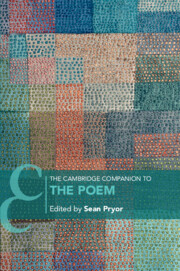Book contents
- The Cambridge Companion to the Poem
- The Cambridge Companion to the Poem
- Copyright page
- Contents
- Figures
- Contributors
- Acknowledgments
- Chronology
- Introduction
- Part I Ideas of the Poem
- Part II Forms of the Poem
- Part III The Poem in the World
- 13 Decolonizing the Poem
- 14 The Poem as World
- 15 The Poem and Its Audiences
- 16 The Poem in the Archive
- 17 The Poem and the Commodity
- 18 The Poem in the Digital Age
- Further Reading
- Index
- Cambridge Companions To …
14 - The Poem as World
from Part III - The Poem in the World
Published online by Cambridge University Press: 30 May 2024
- The Cambridge Companion to the Poem
- The Cambridge Companion to the Poem
- Copyright page
- Contents
- Figures
- Contributors
- Acknowledgments
- Chronology
- Introduction
- Part I Ideas of the Poem
- Part II Forms of the Poem
- Part III The Poem in the World
- 13 Decolonizing the Poem
- 14 The Poem as World
- 15 The Poem and Its Audiences
- 16 The Poem in the Archive
- 17 The Poem and the Commodity
- 18 The Poem in the Digital Age
- Further Reading
- Index
- Cambridge Companions To …
Summary
Can a poem create a world? Among other poets, Wallace Stevens affirms a poem's capacity to make a mountain or even a planet. This chapter examines the history behind the idea of the poem as worldmaking, from Renaissance ideas rooted in antiquity, through Enlightenment concepts such as heterocosm, to modernist ideas of autonomy, including W. H. Auden's “secondary worlds.” Allowing for subsequent historicist, political, and poststructuralist critiques of such ideas, it argues for the enduring value of the concept of poem as worldmaking. Some theorists of lyric have advanced a notion of the poem as a ritualistic event of enunciation and others have held that the poem, even if not primarily mimetic, still evokes a world. This chapter argues for a synthetic model of the poem as enacting an event in language and as also producing a polyspatial, polytemporal world, as exemplified by poems by Patience Agbabi, Margaret Atwood, Tracy K. Smith, and others. Drawing on the field of world literature, it explores how the poem's transnational and transhistorical travel worlds the world. Analyzing a poem by A. K. Ramanujan, it asks about the ethical implications of a poem's worldwide reach.
Keywords
- Type
- Chapter
- Information
- The Cambridge Companion to the Poem , pp. 230 - 248Publisher: Cambridge University PressPrint publication year: 2024



